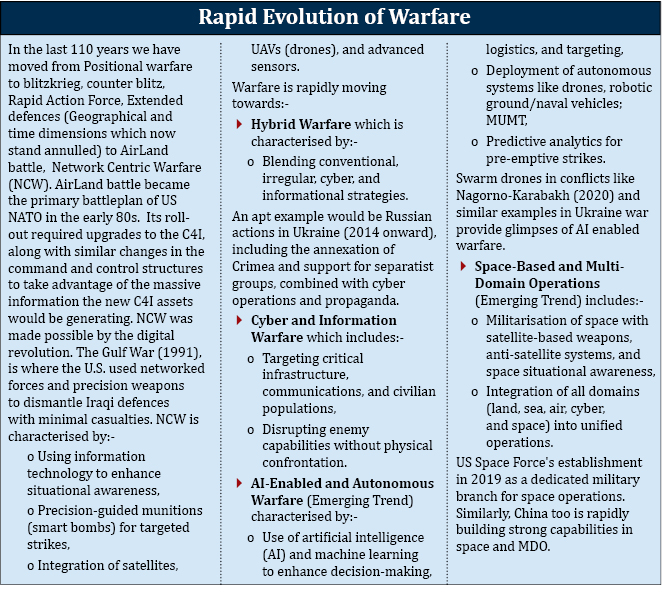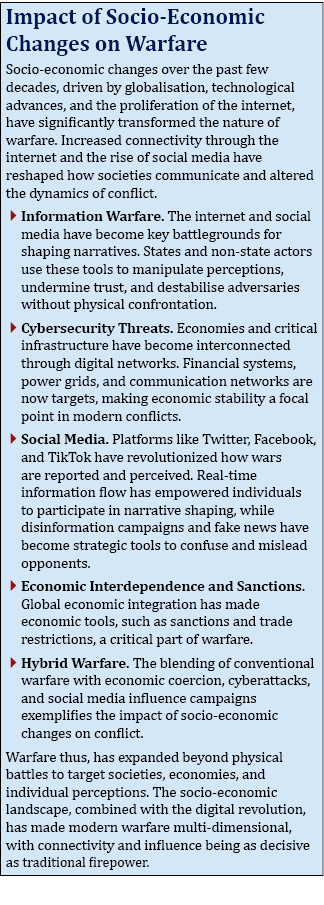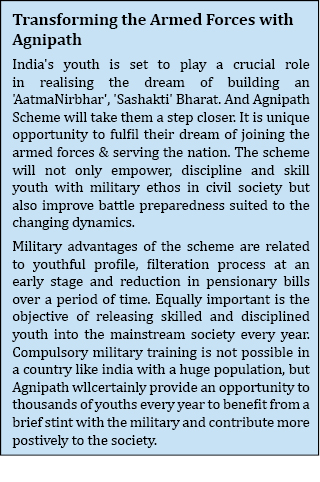
Articles
Military Transformation must be guided by Security Doctrine
Sub Title : In this era of Military Transformation, the Indian Armed Forces must recognise and embrace the evolving nature of warfare, establishing a robust doctrine as its foundational pillar
Issues Details : Vol 18 Issue 6 Jan – Feb 2025
Author : Col Ashwani Sharma, Editor-in Chief, South Asia Defence & Strategic Review
Page No. : 22
Category : Military Affairs
: January 25, 2025
Military transformation can be defined as the changes that a nation’s military brings about to achieve specified objectives. Militaries across the globe have been continually changing and evolving. However, rapidly advancing technologies of today and resets in global geopolitics are now underscoring the need for such transformation as never before. As India embarks on this journey, we outline the process and drivers of India’s military transformation
Technological advancements over the past few decades have significantly changed the way wars are fought. Modern warfare is no longer limited to land, air, and sea but also includes information, social, and psychological tactics alongside physical battles. Today’s strategies, training, and technology operate in three main areas: physical (material aspects in combat), human ( psychological, social, emotional)and CEMA (Cyber Electromagnetic Activities).
This makes it imperative for militaries to so transform that they can keep in sync with the changing nature of warfare. Hence, the aim of Military transformation, in the present day context, is to shape the armed forces into an agile, net-centric, knowledge-based force capable of conducting effective joint and combined military operations against potential future adversaries.
Warfare thus, has expanded beyond physical battles to target societies, economies, and individual perceptions. The socio-economic landscape, combined with the digital revolution, has made modern warfare multi-dimensional, with connectivity and influence being as decisive as traditional firepower.
Military transformation can be defined as the changes that a nation’s military brings about to achieve specified objectives. There are a number of perspectives through which military transformation may be viewed as there is no standard template for every military. It is influenced by a military’s prevailing state vis-a-vis its future objectives. For example, the military transformation pillars identified by the US military are:
- Strengthening joint operations,
- Exploiting US intelligence advantages,
- Concept development and experimentation,
- Developing transformational capabilities.
For the UK armed forces it is (i) Force structure; (ii) Modernisation and (iii)Training.
In India, the need for military transformation was felt at the turn of the century especially after the Kargil conflict. Some reforms including an attempt at self-reliance by galvanising the Indian defence industry and reducing dependence on Russia and Eastern Europe for military hardware were ushered in, but the sense of urgency for reforms has increased after the Modi government came to power. It started with Aatamanirbhar Bharat – a clarion call to ‘Make in India’. Creation of DMA and appointment of CDS were next in the line of reforms aimed at ushering in jointmanship and efficiency. Then came Agnipath – a fresh approach to HR with the stated aim of achieving a younger profile, reducing the pension burden and releasing a steady stream of disciplined youth with a nationalistic mindset into the civvy street. Simultaneously, there is a buzz about rebalancing and downsizing the forces, particularly the army which is looking at improving the ‘tooth to tail ratio’.
Sino-India military confrontations at the LAC and India’s emergence as a regional player has spurred the Indian military apparatus to look at ways to become more efficient even though the resources remain limited.
In India’s case Military transformation could broadly consist of the following:-
- Theatre commands and Force structure,
- Force modernisation to include CEMA and Space,
- Training philosophy,
- Sustainability and logistics.
But where and how does the process begin? In countries with powerful militaries like the US, China and Russia, the directions always emanate from the very top. National security policy is defined with clear goals for the military by the Head of state/executive. Military goals, capability and capacity are derived from such a strategic direction. Thus, the imperative need for a National Security Strategy laid out by the National Security Apparatus. In India the Cabinet Committee on Security (CCS) headed by the Prime Minister (see box) is at the apex and must formulate such a strategy. This should lead to a pragmatic Military Doctrine. Transformation, in turn, must flow out of the warfighting doctrine.
The Present Day Dilemma of Military doctrine
When the cold war era ended with the collapse of the Soviet Union in the early 1990s it was believed that the threat of a conventional war will diminish slowly and will lead to grey zone tactics instead. Come February 2022 and the multipronged offensive in Ukraine changed all of that. It has demonstrated that nations are prepared to invade and attack. The Ukraine conflict has provided an opportunity for military observers to analyse multiple facets of warfighting. It has also provided a window into how today’s wars require a level of agility, and rapid innovation and integration that has never been executed at this scale by a nation’s military. This extraordinarily prolonged conflict has proven that Russia’s military doctrine was flawed – their planning for this incursion was not comprehensive; and their command and control capability has been lacking. At the tactical level, it is to Ukraine forces’ credit to have embedded agile principles into their approach to defending their country. Rapid innovation, inventive tactics, and accelerating the integration of novel ideas and approaches to repel Russia’s military advantage have made a significant difference to how this conflict has developed.
The challenge posed by the current situation is that warfare has evolved faster than the warfighter. Today, a military’s ability to incorporate new technologies with an effective supporting infrastructure is critical to achieving its objectives, whether on the tactical, kinetic contact battlefield or in the realm of non-kinetic statecraft and psychological dominance.
Military Doctrine – Factors
National Security Strategy. The first factor is the National Security Strategy, the very source from which the doctrine must originate, as mentioned above briefly. Threats and challenges, current and future, at the national, regional and global level must be clearly spelt out in this policy document. Militaries would derive their objectives from this document and arrive at the capabilities and capacity needed to address the challenge. The process must remain dynamic and the national goals must undergo periodic revision or when necessitated by circumstances.
Geographical location and Attributes. It includes the country’s borders and its area of influence where the armed forces may be required to operate. Space and cyber domains which do not have an identifiable physical boundary are added as domains of responsibility where the military must exercise appropriate control. Physical attributes of the terrain as it obtains in the area of operations have a dominating impact on operational plans, particularly in the case of land forces followed by the maritime and the air arm, in that order. Terrain must be exploited to gain maximum advantage from the natural lay of the land.
Artificial obstacles and infrastructure must be developed to maximise the advantages that terrain offers and enhance the effect as per intended design of operations.
In the maritime domain the naval fleet must extract the most out of the island territories, littoral states, natural defiles created by gulfs and bays and traditional shipping lanes. Maritime assets and the capabilities that come with them should be in line with the maritime doctrine.
Demographic Factor and HR. Demographic dividend is the potential that can result from shifts in a population’s age structure, mainly when the share of the working-age population (18 to 65) is larger than the non-working-age share of the population. It is largely related to the economic component, but is an essential ingredient of policy on defence as availability can have a direct bearing on recruitment philosophy. Employment philosophy (operational) and training the human resource are also closely connected to the demography. Countries with small populations do not have a choice but to resort to compulsorily military training and maintain smaller standing armies even if the operational requirement is greater. Those with larger populations can exercise the option of recruiting as many as they need and can afford.
Imparting military training for a short period of time and then releasing such a disciplined pool of HR into the mainstream of society has many positives for the country (see box – Agnipath). In recent years the Indian defence services have undertaken several initiatives to induct women at multiple levels within their ranks which includes opening up combat roles for them.
- Women in Combat. This is in the spirit of empowerment, equal opportunities and career options for all, and selecting the best available HR talent. But the national security apparatus will do well to remember that in matters military operational readiness and effectiveness is the sole criteria. Armed forces are not mandated with the responsibility to generate employment or provide gender equality in the battlefield. The Military doctrine must dictate the HR policies implicitly based on operational requirements which the demographic realities of the nation can support.
Industrial Capability and Capacity. The current Ukraine – Russia conflict and to an extent the West Asian conflicts are apt case studies which amplify the inescapable need for self-reliance in defence. In an increasingly interdependent (and interconnected) world which is constantly seeking removal of barriers to achieve free trade, having a closed door policy becomes difficult and in some cases economically unviable. At the same time self-reliance in defence ought to be every country’s just aspiration. It is thus a delicate balance wherein you build adequate capability and capacities within your own country particularly in areas deemed critical to your military needs. In an increasingly flatter world, 100% indigenous capability is neither possible nor desired. It thus boils down to certain core military technologies, platform integration, engineering capability and the necessary infrastructure which may be ramped up if and when required.
Economics and Military Doctrine. A pragmatic military doctrine must be based on realistic appraisal of resources of which financial muscle is an important constituent. Defence budgets will be limited and invariably fall short – a given for almost all militaries. Two important inferences thus: (i) Military doctrine must be based on a realistic appraisal of available resources; (ii) in order to extract the most out of the available money, the doctrine should eliminate all leakages and non-essential expenses.
Heritage and Traditions. An understated aspect of military doctrine. Military analysts and historians will readily agree that every military is different and operates in a peculiar manner. Some are ruthless, some are fanatical and some suffer from an indifferent air of arrogance. Some are very traditional in their ways and some are simply religious armies. Indian military has its own ethos – Dharmayudhha and its tenets are deeply ingrained in the psyche of Indian soldiers. There’s an honour code that the Indian military follows. It relies a lot on leadership, abundant unit pride and of course ‘Naam’, ‘Namak’, ‘Nishaan’. The method of warfighting must always be based on the value system that the military enjoys.
Effective Doctrine: Prescriptive or Adaptable?
Since the turn of the century, rapid emergence of technology has changed the way we fight. The last century began with positional warfare, switched to manoeuvre warfare in merely two decades, got refined to Air-land battle concept, and finally NCW came into effect with the advent of IoT and modern electronics.
We now talk about the 6th generation warfare which primarily refers to stand off warfare utilising remotely operated platforms and precision munitions. Add to this concurrent engagement in
4th Gen (decentralised actions), and 5th Gen (non-kinetic actions) and we have a dynamic situation in the TBA. Traditional methods are unable to cope with such upheavals There are numerous examples of departure from established military doctrine with great success. Overly prescriptive doctrine can readily turn into dogma; and whilst no military should be forced into shortcuts, the present day conflicts are demonstrating what can be done when forced to adapt. Doctrines, therefore, must remain adaptable.
In conclusion, it will be right to state that whilst having the right tools is important, having the agility and innovativeness to try new things in different ways, adopt and use them at the relevant pace is what generates unexpected, powerful outcomes and success.





